Messerschmitt Bf 109 E-3
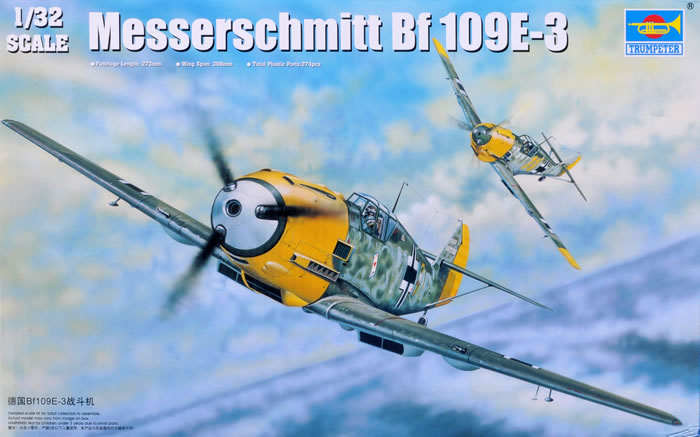
Trumpeter, 1/32 scale
S
u m m a r y |
| Catalogue Number and Description: |
Trumpeter Kit Number 02288 - Messerschmitt Bf 109 E-3 |
| Scale: |
1/32 |
| Contents and Media: |
266 plastic parts in light grey plastic; eight clear parts; three vinyl
tyres; photo-etched fret; markings for three
aircraft |
| Price: |
AUD$49.95, distributed in Australia by J.B. Wholesalers
Available through specialist hobby shops worldwide |
| Review Type: |
FirstLook |
| Advantages: |
High quality mouldings; includes engine and interior parts for rear fuselage and wing cannon; finely recessed panel and rivet line detail; separate poseable slats, flaps and control surfaces; separate exhaust stacks with hollow ends; useful options including centreline bomb, drop tank, three styles of spinner cap; well-produced decals. |
| Disadvantages: |
Spinner and propeller assembly of questionabl e shape and underdetailed; oversized oil cooler housing; peculiarities in cockpit; canopy parts too wide; bottom to side fuselage transition too sharp; flat detail on wheel hubs; no pilot's hatch door in rear cockpit panel. |
| Conclusion: |
Trumpeter's 1/32 scale Messerschmitt Bf 109 E-3 features state-of-the-art moulding, lots of interior detail and looks to be a pretty straightforward build but there are a surprising number of accuracy issues for such a well documented aircraft. |
Reviewed by Brett Green

Trumpeter's 1/32 scale Messerschmitt Bf 109 E-3 is available online from
Squadron
The Messerschmitt Bf 109 A, B, C and D were powered by the Junkers Jumo engine. The Spanish Civil War presented the opportunity to test these revolutionary fighters in action, and they proved their worth in combat with Legion Condor over the skies of Spain.
The Messerschmitt Bf 109 E series was the first of the family to be fitted with the Daimler Benz DB601A engine, resulting in a significant improvement in performance.

Two variants were manufactured in parallel - the lightweight Bf 109 E-1 which retained the wing-mounted 7.9mm machine guns of the earlier Bf 109 B, C and D; and the Bf 109 E-3 which was fitted with one 20mm MG FF cannon in each wing. Both variants featured two additional 7.92mm machine guns in the cowl.
1,540 Bf 109 E-3s were delivered. They saw first saw service with Legion Condor in Spain, then continued in widespread action alongside the Messerschmitt Bf 109 E-1 in Poland, the Low Countries, across the English Channel in the Battle of Britain and in the Balkans.
Hasegawa's and Matchbox's 1/32 scale Messerschmitt Bf 109 E-3/4 kits have been around since the 1970s, while Eduard launched their family of Emils during 2009. Eduard's kits represented a great leap forward when compared to the earlier generation of Emils.
Now Trumpeter has entered the fray with their 1/32 scale Messerschmitt Bf 109 E-3.
Trumpeter's 1/32 scale Messerschmitt Bf 109 E-3 comrpises 266 plastic parts in grey plastic; eight clear parts; three vinyl tyres; photo-etched fret and markings for three aircraft.
The overall dimensions of the model conform to published plans.
Surface detail is some of Trumpeter's best yet, with petite and crisply recessed panel lines supplemented by very subtle rows of rivets. These should look great under paint.
Parts breakdown is pretty conventional, with a full-span lower wing, upper wing halves and two fuselage halves. The slats and flaps are provided separately, as are the ailerons, and rudder. They may all be glued in neutral or deflected poses according to the modeller's preference. Elevators are moulded in a neutral stance with the upper horizontal stablisers, but it would hardly be a stretch to remove and reposition these.
A large amount of interior detail is supplied including a full engine bay with individual hollowed out exhaust stacks, rear fuselage interior and MG FF cannon in the wings. Useful options include three styles of spinner cap, centreline bomb and drop tank.
The engine is noticeably undersized to permit the engine cowl to fit over the top. This downscaling of the engine is necessary due to the almost unavoidable thickness of the plastic of the engine cowling. Be prepared for some fiddling to insert the machine guns through the holes behind the gun troughs if you want to actually remove and replace the engine cowl on the completed model.
The big photo-etched fret contains optional radiator and oil cooler grilles, pilot's head armour, wheel bay liners, harness straps and more. I recommend that you anneal the photo-etched fret by heating with a candle and dunking in water to soften the metal before bending the parts into shape - especially for the wheel bay liners (Parts PE 16, 17, 23 and 24).

The cockpit is fairly well fitted out but will benefit from some extra detailing in this large scale. Two errors should be addressed too. First, Trumpeter has inexplicably placed the housing for the centreline cannon from a Bf 109 F/G in this cockpit. Do not install Parts E33 and E49. Also, there is no pilot's stowage hatch in the upper rear cockpit bulkhead (Part E22). You might like to scribe this in place.
Rear fuselage interior detail includes several shelves, oxygen bottles and radios. These may be viewed through the separate fuselage hatch.
Yet more interior detail is provided with the wing-mounted MG FF 20mm cannon. Clear blisters are supplied for the bottom of the wings (you could leave them unpainted if you felt so inclined), but the top wing access hatches are moulded shut.
Two large decal sheets offer three marking options, including one bold Swiss aircraft with red and white stripes. Some modifications will be required to the gun troughs and bulges for this option so consult your references.
For those who are concerned about accuracy, there are a number of issues worth mentioning. Starting from the front and working back:
The spinner and propeller assemblies are not so good. The shape of the spinners lack the subtle curves of the real items, with the shape of the common blunt spinner being particularly poor.
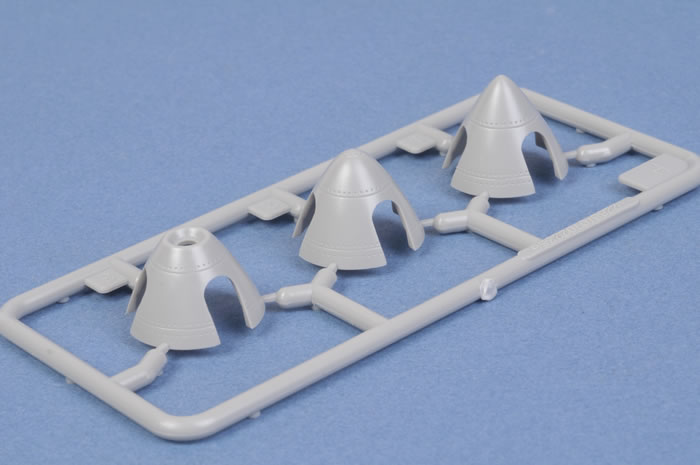
The prominent propeller hubs are missing the busy spline detail so obvious on the full-sized aircraft too.
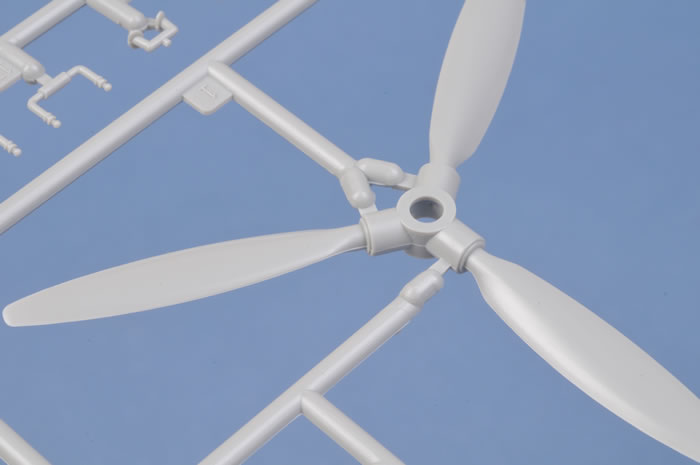
The oil cooler housing under the nose is clearly oversized, especially in width.

The canopy parts are noticeably too wide, and they flare out slightly toward the front. The overly pronounced width carries over from the cockpit opening to the top of the canopy. On the canopy centre section, the part seems to be up to 2mm too wide at the base and around 3mm too wide at the top. It looks broad and flat as a result.
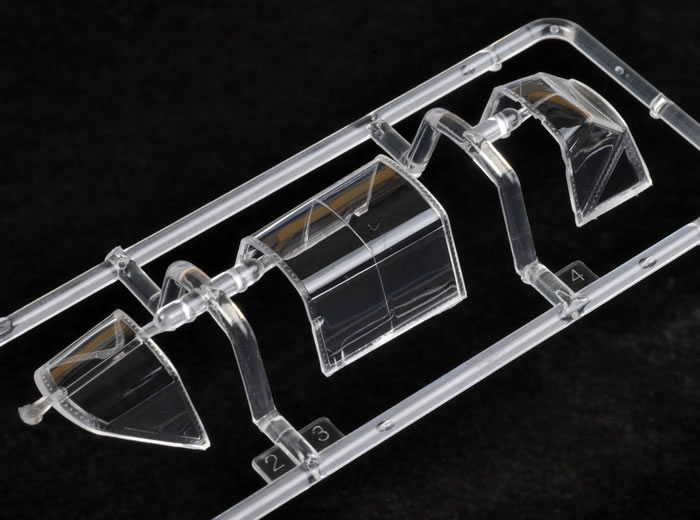
I think the problem stems from another issue with the fuselage. On the real Messerschmitt Bf 109, the fuselage area immediately aft of the wing root (fuselage Station 2) transitions at a smooth angle from the bottom to the side of the fuselage. The fuselage then gently tapers inward to the cockpit opening and the top of the fuselage. On the real aircraft, the taper is constant for the length of the cockpit opening (i.e. the width of the cockpit opening is the same at the front as it is at the rear). Trumpeter's fuselage features a very sharp (almost right-angled) transition from the bottom to the side of the fuselage at Station 2, and the side does not taper inward far enough.
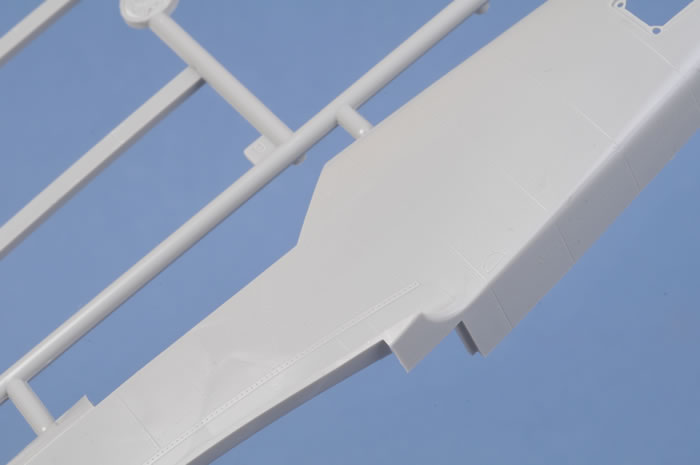
The result is that the fuselage is too wide at the cockpit opening, with the inevitable compound errors on the canopy. The taper is also not constant, so the front of the cockpit opening is around 1.5mm wider than the rear.
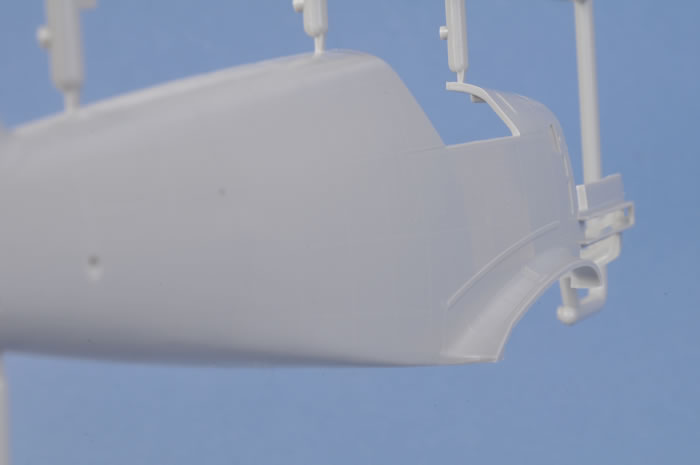
The wheel hubs suffer from flat detail. These may be replaced by after-market items already available from a number of manufacturers.
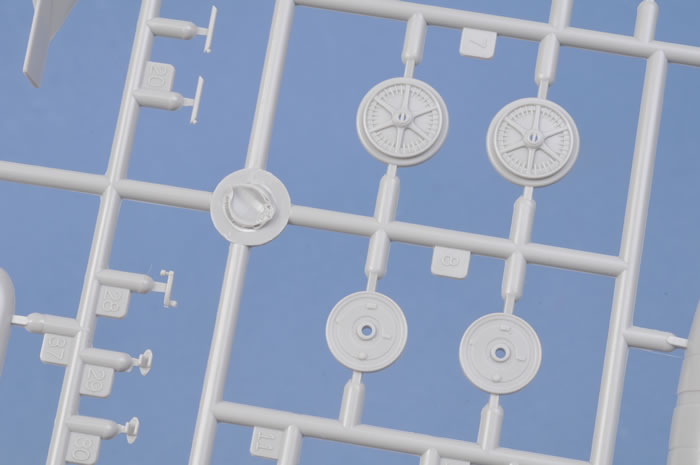
Trumpeter's 1/32 scale Messerschmitt Bf 109 E-3 features state-of-the-art moulding, lots of interior detail and looks to be a pretty straightforward build but there are a surprising number of accuracy issues for such a well documented aircraft.
I suppose it really depends on what sort of modeller you are. Some will genuinely not care about the wide oil cooler and canopy, the undersized engine, the underdetailed spinner hub and wheels, and the oddities in the cockpit. If you don't care, it does not make you a lesser modeller. If that is your view, just build it.
On the other hand, if the accuracy issues do bother you, some may be fixed quite easily. You might swap out a spare spinner from an Eduard kit to replace the Trumpeter item. The cockpit can be detailed and corrected without too much trouble. nrma parraThe cowling can be glued in place to hide the small engine. The main wheels may be replaced with after-market parts. However, correcting the other issues - the oversized oil cooler housing, the transition of the bottom to the side of the fuselage and the wide canopy - are probably beyond the skills of the average (or even above average) modeller.
In summary, this is generally a nice kit but it seems a shame that Trumpeter has missed the opportunity to create the definitive 1/32 scale Messerschmitt Bf 109 E for the sake of a little extra research and want of expert feedback prior to moulding.

Text and Images Copyright © 2010 by Brett Green
Page Created 28 March, 2010
Last updated
29 March, 2010
Back to HyperScale Main Page
|
